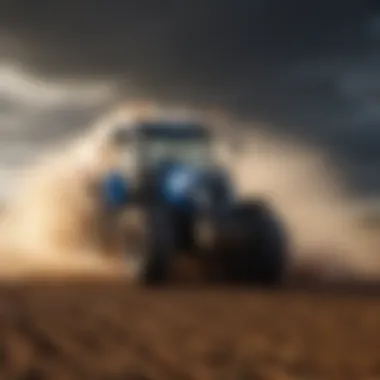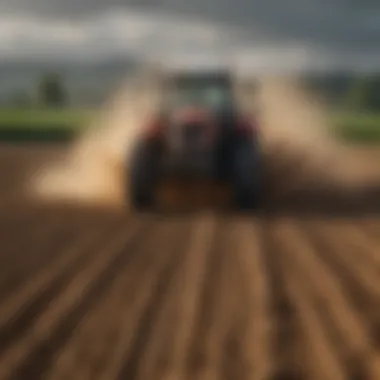Exploring Powder Show in Agriculture: Impacts & Insights


Intro
The phenomenon of powder show is increasingly significant within agriculture. As farming practices evolve, understanding the role of powdery substances is vital. Powders can be found in various materials relevant to agricultural practices. These include fertilizers, pesticides, and seed coatings. These materials can enhance efficiency and sustainability in farming. The need for innovative solutions is growing, making this subject both timely and necessary for advancement in agricultural techniques.
Topic Overview
Definition and Importance
Powder show refers to the presentation and application of agricultural materials in powder form. These materials can serve multiple purposes, such as improving soil health, managing pests, and delivering nutrients. The importance of powder show cannot be overstated. This format allows for better distribution and absorption of essential inputs in the soil and plants. It also aids in reducing waste and enhancing the efficacy of inputs. This can lead to more sustainable practices within the agricultural sector.
Brief History and Evolution
The use of powders in agriculture has a rich history. Early farmers utilized finely ground materials like bone and blood meal as fertilizers. Over time, the development of chemical fertilizers in powdered form brought about a shift in farming practices. The evolution of technology has further refined these processes, allowing for new formulations and applications. Today, advancements in powder technology play a crucial role in achieving higher crop yields and addressing environmental concerns.
Key Techniques and Innovations
Sustainable Farming Practices
Powder form materials support sustainable farming. They allow for precision application methods that minimize waste. Techniques such as variable rate technology ensure that the right amount is applied in the right place. This not only saves resources but also enhances crop health. Key practices include:
- Direct application methods: Applying powder directly to soils.
- Coatings for seeds: Enhancing germination rates and early plant health.
Advanced Agronomic Technologies
Technology has significantly impacted the powder show. Innovations in formulation and application have made it easier to utilize these materials effectively. Some advanced techniques include:
- Controlled-release formulations: Gradually releasing nutrients for better uptake.
- Nano-powders: Smaller particle sizes increasing surface area and absorption rates.
Practical Applications
Step-by-Step Guides
Implementing powder show techniques involves several steps. Farmers can follow these guidelines:
- Select appropriate powder materials: Based on soil tests and crop requirements.
- Determine application rates: Using tools like soil moisture sensors.
- Apply using appropriate technology: Such as aerial application or ground equipment.
- Monitor outcomes: Evaluate the results to adjust future applications.
Case Studies or Real-World Examples
Many farmers have benefited from adopting powder show techniques. For example, in California, growers using powdered fertilizers reported an increase in yields by 20% compared to traditional methods. Additionally, a collaboration in Europe developed powdered pest control substances that reduced chemical usage by 30% without impacting efficacy.
Conclusion:
The dimensions of powder show hold immense potential for improving agricultural productivity. As more farmers adopt these techniques, the way agriculture is practiced will continue to evolve.
Understanding Powder Show
The concept of powder show is increasingly relevant in the agricultural context. Understanding this phenomenon is pivotal for farmers and agricultural professionals seeking to leverage advancements in agronomy. Powder show refers to the behaviors and characteristics exhibited by powdered materials when distributed in various environments. This includes how they settle, disperse, and interact with other components in the soil or atmosphere.
Definition and Concept
Powder show encompasses both the physical and chemical properties of powdered substances. These substances often range from fertilizers to pesticides and soil amendments. By understanding the term itself, one can appreciate the critical aspects of flowability, dispersion, and particle size.
Farmers need to grasp how these features directly influence efficiency in application and overall effectiveness. Knowing, for instance, that smaller particles might settle more quickly can steer decisions regarding application methods and timing. Thus, investigating the dynamics of powder behavior adds significant value to agricultural practices.


Historical Context
Historically, powder technologies have evolved alongside agricultural practices. Initially, farmers relied on bulky granules or liquid formulations. These methods often resulted in uneven distribution and inefficient application rates. The advent of powdered forms allowed for more precision, leading to improved nutrient efficiency.
Over the past few decades, technological advancements have further transformed powder show applications. The integration of engineering principles into agricultural methods has resulted in better storage solutions and application technologies. This evolution highlights the importance of staying informed about powder show developments. Understanding past challenges and solutions can inform current practices and inspire future innovations.
The Role of Powder Show in Agriculture
The intersection of powder technology and agriculture represents a significant advancement in farming practices. The role of powder show in agriculture embodies several critical aspects that enhance efficiency, productivity, and sustainability. The application of powder formulation techniques offers farmers unique solutions for nutrient delivery, soil enhancement, and pest management. Understanding these applications allows agricultural practitioners to make informed decisions that can lead to better crop yields and optimized resource use.
Nutrient Delivery Systems
Nutrient delivery systems that utilize powder formulations have emerged as a preferred method for precise fertilization. These systems allow for controlled release of nutrients, ensuring that plants receive essential elements in adequate amounts. The granulated or powdered nutrients are easy to apply and can be mixed into the soil or delivered through irrigation systems. This flexibility aids in minimizing nutrient loss due to leaching. Moreover, the targeted application reduces fertilizer runoff, contributing to improved water quality in surrounding ecosystems.
The use of powders also enhances the efficiency of nutrient assimilation by plants. They can be formulated to include not only macro-nutrients like nitrogen, phosphorus, and potassium but also micro-nutrients that contribute to overall plant health. Advancements in coating technologies ensure that nutrients are released gradually, matching the needs of crops throughout their growth cycle. This adaptive approach signifies an evolution in how farmers address fertility challenges.
Soil Amendments
Soil health is essential for productive agriculture. Powder applications for soil amendments offer a practical solution to enhance soil structure, fertility, and microbial activity. Common soil amendments include powdered lime, gypsum, and organic matter derivatives, which improve pH levels and nutrient availability. The versatility of powders also allows for easy incorporation into conventional tillage practices or no-till systems.
By applying powders, farmers can improve cation exchange capacity, aiding in nutrient retention. Additionally, powdered organic matter provides vital organic content to soil, fostering a conducive environment for beneficial microorganisms. These interactions contribute to soil resilience, impacting long-term crop productivity positively. Thus, adopting powder formulations for soil amendments not only enhances immediate crop growth but also promotes sustainable farming practices.
Pest Control Applications
The use of powder show in pest control applications highlights the innovative approaches being developed within the agricultural sector. Powders serve as carriers for biological insecticides, herbicides, and fungicides that can be applied with high precision. These formulations address pest threats while minimizing exposure to non-target species and the environment.
The powdered application method allows for uniform distribution, which ensures that specific areas of a field receive the right treatment. This targeted strategy reduces the quantity of chemicals used and overall costs, leading to more sustainable pest management. Additionally, recent advancements have introduced biodegradable powders that break down over time, leaving minimal residues in the soil or crops.
Advantages of Using Powder Formulations
Powder formulations hold a significant place in modern agriculture. They offer a range of benefits that can enhance farming practices. By delving into the advantages of powder formulations, we see how they support not just efficiency but also sustainability, alongside offering tailored solutions for specific agricultural needs.
Improved Efficiency
Using powder formulations can streamline several processes in agriculture. When comparing powdered materials to liquid forms, one finds that powders require less volume for application. This can lead to faster coverage of fields, better absorption, and reduced waste. For instance, when applying fertilizers or pesticides, powders often have a higher concentration of active ingredients. As a result, farmers can achieve desired results without needing large quantities. This efficiency translates not only to cost savings but can also lead to quicker results in terms of plant growth and health.
Furthermore, powder formulations can increase the effectiveness of nutrient delivery systems. They may dissolve or disperse uniformly within soil or irrigation systems, ensuring that key nutrients reach plant roots efficiently. Farmers observe that precise application leads to healthier crops and often increased yields.
Customization Potential
Powder formulations are notably adaptable. Farmers can design or select specific mixes to cater to various types of soil and crops. This customization is possible due to the diverse range of components that can be included in powder form. By doing so, they can target specific deficiencies within the soil or tailor pest control measures to the unique environment of their fields.
For example, if a farmer identifies a deficiency in nitrogen, they can utilize a powder formulation designed specifically to address that shortcoming. This level of customization allows for more effective use of resources, ensuring that applied substances are fit for purpose. The flexibility also enables farmers to adjust their strategies based on real-time feedback from their growing conditions.
Reduced Environmental Impact
The use of powder formulations can lead to a decreased environmental footprint. Unlike some liquid chemicals that may run off into waterways during rain events, powdered applications are less likely to contribute to such issues. Powders often have better soil attachment, reducing potential leaching and promoting environmental safety.
Additionally, targeted application techniques that are possible with powders can further reduce waste. Focusing on exact areas that require treatment helps in minimizing the usage of chemicals and fertilizers, which in turn preserves surrounding ecosystems. The impact on biodiversity is generally less pronounced, as farmers can avoid over-application.
"The strategic use of powder formulations not only enhances crop performance but also aligns with global sustainability efforts."
Key Powder Show Technologies


In the realm of agricultural practices, the adoption of key powder show technologies has emerged as a catalyst for enhancing both efficiency and effectiveness in operations. These technologies play a critical role in the successful deployment of powder formulations. Understanding these mechanisms is essential for farmers and agricultural professionals who seek to optimize their processes. The effectiveness of powder show hinges on technical advancements that enable better handling, storage, and application of powdered materials.
Spray Technologies
Spray technologies are a vital component of the powder show applications in agriculture. These systems facilitate the precise application of powdered products to crops and soil. They allow for uniform distribution and help ensure that the intended nutrients reach the target areas efficiently.
Some of the common types of spray technologies include:
- Aerial spraying: Often utilized for large fields, this method offers vast coverage and effectiveness for applying various powders.
- Ground sprayers: These machines can navigate through different terrains, providing versatility and precise targeting.
- Electrostatic sprayers: Utilizing electric charge, these sprayers enhance powder adhesion to plant surfaces, boosting effectiveness and reducing waste.
The benefits of implementing advanced spray technologies include improved application rates and minimized drift. Additionally, using these methods can lead to better crop yields and reduced resource wastage. Farmers can achieve targeted solutions, maximizing the potential of their inputs while minimizing environmental impact.
Silo and Storage Solutions
Silo and storage solutions are also crucial in the context of powder show technologies. Proper storage of powdered materials is essential for maintaining their quality and accessibility. Ensuring optimal storage conditions prevents material degradation and ensures the longevity of the product. This aspect is particularly vital, given the sensitivity of many agricultural powders to moisture and pest intrusion.
Key considerations in effective silo and storage designs include:
- Material integrity: Silos constructed from durable materials prevent contamination and preserve the quality of the powders.
- Moisture control: Implementing appropriate moisture control systems prevents clumping and ensures the ease of flow during application.
- Accessibility: Well-designed storage units facilitate easy access for farmers, allowing for a more streamlined workflow during application times.
Overall, efficient silo and storage solutions not only enhance the usability of powdered materials but also optimize the broader agronomic strategies employed in farming operations. Effective management of these resources reinforces the agricultural supply chain and ensures that farmers can maximize productivity with the help of powder show technologies.
Key takeaway: The integration of advanced spray technologies and robust silo solutions significantly influences the successful implementation of powder show in agriculture. They contribute to increased efficiency and effectiveness through improved application and storage practices.
Challenges Associated with Powder Show
The topic of challenges associated with powder show is essential in the broader discussion of its applications within agriculture. As agriculture continues to evolve, embracing technological advancements and innovative solutions, it is crucial to address the hurdles that come with integrating powder formulations into existing methods. Understanding these challenges is vital for both farmers and the agricultural industry as a whole. By recognizing limitations, potential risks, and best practices, stakeholders can leverage the benefits of powders while minimizing issues that may arise.
Handling and Application Issues
One of the most pressing challenges in using powder formulations in agriculture pertains to handling and application. Powders can be lightweight and vary in particle size, which affects their behavior during application. Farmers often face difficulties in ensuring a consistent spread of the product across fields. Variations in moisture levels, wind, and other environmental factors can impact how powders disperse.
Proper calibration of equipment is necessary to optimize application rates. If not adequately addressed, inappropriate application can lead to uneven coverage and decreased efficacy. Furthermore, using the wrong machinery for handling powders may result in blockages or excessive dust, which can present hazards for both the operator and the surrounding environment.
To mitigate these handling issues, it’s essential for farmers to receive training on safe and effective application techniques. In addition, investing in quality equipment specifically designed for powder applications can improve performance and reduce complications.
Compatibility with Existing Systems
Another critical challenge is ensuring compatibility between powder formulations and existing agricultural systems. Many farming operations utilize a combination of liquids and granular products. Transitioning to powder systems requires a thorough evaluation of current machinery and procedures.
Certain powders may not dissolve or mix well with liquid fertilizers, pesticides, or other products. This incompatibility can lead to ineffective applications and wasted resources. Compatibility issues may also arise regarding storage solutions; powders that require specific humidity or temperature conditions need particular attention to prevent clumping or degradation.
Farmers should analyze their current systems and investigate whether they can incorporate powders without major changes. This analysis may involve consulting with agricultural specialists, manufacturers, or conducting field trials. Understanding the entire lifecycle of powder use—from storage to application—will enhance efficiency and effectiveness in utilizing these products.
"Addressing challenges is crucial for successful integration of powder technologies in agriculture; preparation and compatibility can maximize the benefits."
Case Studies of Powder Show Applications
The examination of case studies related to powder show applications is crucial for understanding the practical value of this concept in agriculture. It provides an empirical foundation that illustrates the effectiveness or challenges of using powder formulations in real-world scenarios. By analyzing various implementations, one can draw insights on best practices, risks, and the overall impact on agricultural productivity. Furthermore, these case studies illuminate specific aspects such as user experience, cost implications, and environmental considerations, which are essential for any practitioner involved in modern farming.
Successful Implementations
In the realm of agriculture, several successful implementations of powder show methodologies stand out. These instances serve as models of innovation and efficiency, often leading to notable improvements in crop yield and sustainability.


One prominent case is the use of powdered micronutrients by companies like Yara International. Their innovative approach targeted nutrient delivery systems, efficiently providing essential minerals to crops through a powdered format. Farmers reported enhanced growth rates, improved soil conditions, and a significant increase in overall yield. Utilizing powder formulations allowed for precise applications, minimizing waste and ensuring that the nutrients reached the plants effectively.
Another successful application was seen in pest management. Syngenta introduced a powdered insecticide that allowed farmers to target specific pests with minimal impact on beneficial insects. The formulation’s design facilitated easy dispersal and application, showing effectiveness while preserving ecosystem balance. Consequently, farmers noted not only a decrease in pest populations but also a reduction in chemical usage overall.
Lessons Learned from Failures
While there are success stories, it is equally important to consider failures in powder show applications. Understanding these setbacks can guide future efforts in refining practices and enhancing the efficacy of powder formulations in agriculture.
One key lesson emerged from a case involving a powdered fertilizer that lacked adequate decomposition. Farmers using this product experienced nutrient lockout, as the formulation did not integrate well with certain soil types. This led to unexpected crop deficiencies and ultimately financial losses. Feedback from this scenario highlighted the necessity for compatibility tests prior to launch.
Additionally, a project exploring a new pest control powder faced challenges with distribution and handling. The powder clumped together during transport, rendering it ineffective for actual application. The manufacturer learned that thorough testing and design considerations in product logistics are essential for ensuring reliability in the field. The experience underscored the importance of both product formulation and operational efficiency for successful implementation.
These case studies signify the importance of continuous research and development in the field of powder show applications. They show how valuable insights can be drawn from real-world experiences, leading to better practices, improved formulations, and ultimately, enhanced agricultural outcomes.
Future Trends in Powder Show Technologies
Advancements in agriculture are increasingly taking center stage, and powder show technologies exhibit promising trends. These technologies are vital for improving efficiency and sustainability in farming practices. Farmers and agricultural enthusiasts must understand these developments, as they have the potential to reshape modern farming strategies. Innovative formulations and sustainability considerations stand out among these trends.
Innovations in Formulation
Innovations in formulation are essential in maximizing the benefits of powder show technologies. New materials and processes allow for more effective nutrient delivery systems. For example, scientists are exploring advanced compounds that enhance solubility and dispersibility. These innovations do not only increase the products' effectiveness but also minimize waste.
Recently, there has been a push towards microencapsulation techniques. By encapsulating active ingredients, formulations can achieve longer effectiveness and improve compatibility with various pesticides or fertilizers. These enhancements allow for a more tailored approach to farming, where specific needs of crops can be addressed with greater precision.
"Innovative formulations can revolutionize how farmers view and utilize powder materials in agriculture, making their practices more sustainable and efficient."
Furthermore, the integration of smart technology, like sensors and applications that monitor soil and crop health, can lead to more informed decisions regarding the application of powdered products. This data-driven approach empowers farmers to optimize their usage, leading to better yield and reduced environmental impact.
Sustainability Considerations
Sustainability is now a priority in every sector, and agricultural practices are no exception. Powder show technologies must align with sustainable practices to be viable in the long term. This means that future powder formulations have to focus on reducing ecological footprints and promoting soil health.
One aspect is the development of biodegradable or environmentally friendly materials. These materials greatly reduce the risks of chemical pollutants entering ecosystems. In addition, the push for reduced greenhouse gas emissions in agriculture drives the need for less energy-intensive processes in the production of powders.
Moreover, the use of integrated pest management (IPM) approaches with powder formulations can aid in maintaining biodiversity. For example, using specific powders for pest control can lead to less disruption of non-target species, which is crucial for ecological balance.
Ending
The conclusion is a critical part of any article discussing the dimensions of powder show in agriculture. It synthesizes insights provided throughout the content. Effective conclusions ensure that the reader leaves with a clearer understanding of the topic. They reinforce the main ideas discussed and highlight their implications.
In this article, we have examined various aspects of powder show, including nutrient delivery systems, soil amendments, and pest control applications. Each of these areas illustrates the versatility of powder formulations in modern agriculture. Recognizing their advantages such as improved efficiency and customization potential will also assist farmers in making informed decisions.
"Understanding the implications of powder show can drive sustainable farming practices forward."
Furthermore, this article reflects on the critical challenges that come with using powder formulations. Discussions around handling issues and compatibility with existing systems highlighted the need for ongoing research and adaptation. Future trends in powder show technologies signify a strong direction toward innovations that can enhance agricultural productivity while minimizing environmental impacts.
Recap of Key Insights
The key insights to take away from this article include the following:
- Understanding Powder Show: It is crucial to grasp what powder show entails, including its historical context and modern applications in agriculture.
- Role in Agriculture: Powder formulations play an essential part in nutrient delivery, soil health, and pest control, affecting overall crop productivity.
- Advantages: There are several advantages of using powder formulations, including efficiency, customization, and lower environmental impacts.
- Technological Developments: Noteworthy technologies such as spray systems and advanced storage solutions have improved the use of powder show in agriculture.
- Challenges: Acknowledging the challenges, including handling issues and system compatibility, is vital for success.
Implications for Future Research
Future research into powder show in agriculture holds significant promise. Areas to focus on include:
- Formulation Innovations: Exploring new combinations of powders could lead to more effective agricultural products. Research can delve into how these formulations can be tailored for specific crops or soil types.
- Environmental Impact Studies: It is essential to evaluate the long-term effects of using powder formulations on soil and water quality. Understanding these impacts can guide sustainable practices.
- Technology Integration: Investigating how emerging technologies like precision agriculture can be integrated with powder show practices is vital. These studies can pave the way for smarter and more effective farming techniques.
The overarching goal of ongoing research is to enhance the efficiency of agricultural practices while considering environmental sustainability. This will contribute not only to crop yields but also to long-term health of agricultural ecosystems.



